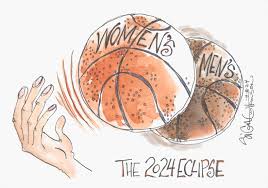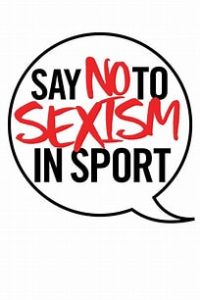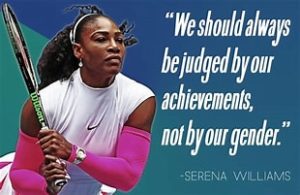1 Chapter One: Sports Feminism
Section One: The Fundamentals
A) What do we know about sport? What are common assumptions we make about sport and society?
| Sport promotes social mobility
The idea of sports promoting social mobility is not available to all people. While sports can promote social mobility to a privileged group, there are a variety of sports that cost a lot of money to join and require valuable parental time. This is especially true for underprivileged children whose parents cannot afford the sports fees. Also, many parents do not have the time or money to travel to expensive out of town tournaments.
I enjoyed reading the discussion submitted on Sports promotes teamwork and unity. This is a metanarrative we would all like to believe. I was pleasantly surprised in the comments regarding the reality of sport. In the competitive arena teamwork and unity are set aside due to pressure to win win and win. This is where cheating and doping are introduced into sport competition. An important point was made that coaching is critical. Coaching must be a lead by example process through approach and attitude to winning and losing.
|
Exercise 3: Notebook prompt
What are some other metanarratives about sport that you are familiar with? Find an image or video clip or draw something yourself that captures this idea…
So what? Why does any of this matter? Does it matter? As something we grow up with – live with – play through – we don’t often interrogate the meanings of sport, and perhaps we don’t want to.
But being aware of these assumptions and metanarratives is especially important, I would argue, because of the centrality of sport to our everyday lives, the role that sport plays in shaping our childhood and worldviews and….. [finish that thought]
| Metanarratives about sport that I am familiar with are, ” Sport promotes a healthy lifestyle”. This metanarrative reinforces the importance of being active. Participation in sport is essential for both physical and mental health. I do agree with this narrative, however it is not the panacea to a healthy life.
“Sport promotes distinction and pride”. This metanarrative is based on the assumption that if a person works hard and is dedicated enough to put in the time and effort there is every possibility of achieving greatness in sport. This is a misleading narrative and can lead to anxiety and depression. The elite class of athlete is not available to everyone. I would change the narrative to “Sport promotes do your best and have fun.”
Yes, it does matter because the majority of metanarratives are misleading. We need to break down and interrogate the metanarratives of sport through a social justice lens. There is an important intersection between social justice and sport. Wetherly et al. (2017) argues a metanarrative of “that sport and leisure can contribute to achieving greater social justice”. Social justice asks the critical question regarding the inequality experienced by many in all levels of sport (Wetherly et al. 2017). I think there is more interrogation today about sport than in the past especially in professional sport. Perhaps those who share a patriarchal view of sport do not want to ask as the question and answer would be an uncomfortable truth to many.
and….. the intersection of gender, feminism and social justice. There is an important interrelationship between feminism, social justice and sport. This is due to the fact that sport does play an integral part of life and our leisure activities whether it is through participation or watching our favourite team sport. The professional sports world is dominated by men. In the study and promotion of social justice Scraton et al. (2013) argue that gender relations are fluid and the intersection of gender and sport change with new feminist positions. Therefore, there is a constant need to promote equality in sport.
|
B) What is social justice?
Exercise 4: Padlet Prompt
Think back to the last section and try to look at some of the ideas we discussed differently. How might sport and social justice actually co-exist?
Record any images, video clips, or gifs you added to the padlet and identify a point of intersection between sport and social justice (can be an issue or a barrier or a debate or something you would like to explore in more depth in this course) . Screenshot or paste in your response below.
| Advocacy and Activism
Sport and social justice can co-exist. Everything is possible with effort and change. The change has to start at the top with a top down approach to eliminate sexism in sport. The elite athletes and coaches must promote inclusion and equity for all. The challenge is to eliminate the many social justice issues grounded in sport and work towards erasing the sexism along with racism, ableism, ageism and recognize LGBTQ rights.
|
C) Social Justice Reading
(note: this activity is optional!)
D) KINESIOLOGY AND SOCIAL JUSTICE
Exercise 5:
Exercise 6:
What are the implications of bodies-at-risk discourse and the refusal to understand the health gap from a social justice perspective, according to the authors of this article?
| According to Harrison et al. the “body-at-risk” discourse is situated in a blame the victim notion referred to as deficit thinking. This pushes whiteness as normal and perpetuates racism. The bodies at risk discourse pushes the notion that marginalized people are different than white people. The implication is the lack of equality and inclusion in sport.
the failure to understand the health gap lends itself to the narrative of black inferiority. Also, the label of being lazy that is given to marginalized and ethnic minorities. The narrative that these groups lack self-management and self-responsibility shows a refusal to understand the health gap from a social justice perspective.
|
Section Two: Sport Feminism
Exercise 7: Notebook Prompt
What is feminism? What does it mean to you? Choose one of the images below and explain how it captures your understanding of feminism (or find one that does speak to you and paste this into your pressbook with an explanation of why it matters to you.
| Feminism is the fight for equal rights for women. The belief of equality in all spheres of life, the economic, political, cultural and social aspects of living in freedom. For me It means, that women are free from oppression, violence and discriminatory practices. Although I subscribe to all types of feminism, I lean toward radical feminism. I feel strongly about the personal experiences of women. The cases of violence against women is just not improving. I turned on the news a week or so ago, and the headlines were so depressing for women’s rights. The two top stories were a woman was killed by her husband for attempting to leave the relationship and the second was another wealthy man in Canada was arrested with countless charges of rape and assault against young women.
|
Exercise 8: Notes Prompt (optional)
NB: Cornell notes is a great resource that teaches effective notetaking. Unfortunately, our system can’t save notes taken in the H5P app, so this is fully optional.
Exercise 9: Crossword Activity
Exercise 10: Padlet Prompt
| Different kinds of Feminism. Liberal feminism is associated with the earliest trail blazers in feminism. This is a base to build on where women are accepted as rational human beings. The law must change for women to have the freedom to choose and create their own world by opening spaces to women. Radical feminism builds on this liberal feminist fight for equality and includes the personal struggles of women. Issues of intimate partner violence, abortion rights and other health issues. Social feminism responses to issues of inequality based in economic opportunities and the division of labour. This oppression is based in racism, ableism and other types of discrimination.
An important concept is, all kinds of feminism are connected. The strong connections is oppression and it circles back to how the system of patriarchy perpetuates male dominance. Women do not have the same and equal opportunities as men. Poststructuralist feminism is an alternative view. I agree with their view that there is not single solution to sport feminism. The opposing view of the poststructuralist feminists to other kinds of feminism is important to understand the complexities of gender, feminism and sport. Also, an alternative theory is critical to keep valuable research into social justice issues at the forefront by asking new questions. In today’s climate there is room for recognition of diversity of what it is to be feminine or masculine. It is important to note that the old questions remain, exploration is essential, however we cannot lose sight that the old questions about inequality in sport are still unresolved. Sport remains a male dominated practice.
|

| Yes, I do believe the landscape for women’s athletics is changing albeit slow. People do care about women’s sport especially the young women themselves. Angel Reese and Caitlin Clark have been a fantastic boost to the sport of basketball. However, I think the challenge for women is in sports that are traditionally male dominated. Sports that are centered on power and strength, such as boxing, rugby and bodybuilding. Women are still forced to add femineity to their athletic performance. If they don’t they are labelled with derogatory terms. Simply not fair.
|



